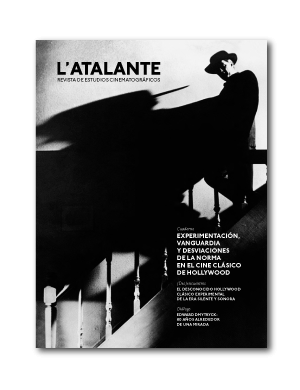Publicado 01.01.2019
Palabras clave
- Laura,
- film noir,
- cine clásico,
- convenciones de género,
- mirada fascinada
- obsesión ...Más
Cómo citar
Mondelo González, E., & Sánchez López, P. (2019). ’Laura’ (Otto Preminger, 1944), el noir y la mirada fascinada. L’Atalante. Revista De Estudios cinematográficos, (27), 75–90. https://doi.org/10.63700/632
Derechos de autor 2019 L'Atalante. Revista de estudios cinematográficos

Esta obra está bajo una licencia internacional Creative Commons Atribución-NoComercial-SinDerivadas 4.0.
Resumen
En las décadas de los años cuarenta y cincuenta, durante el período clásico hollywoodiense, se producen una serie de películas que, con posterioridad, serán englobadas por estudiosos, críticos e historiadores en la categoría conocida como cine negro, en función de una serie de rasgos comunes que permiten su agrupación. En un lugar principal de este canon, y considerada como una de las películas fundacionales en la práctica totalidad de los estudios llevados a cabo sobre el tema, se sitúa Laura (Otto Preminger, 1944). Este artículo se propone, precisamente, cuestionar la adscripción de Laura al canon del cine negro y, mediante un análisis de discurso, tratar de determinar si, a pesar de su casi unánime consideración como ejemplo paradigmático, realmente cumple con las características que los estudios sobre el género sostienen que deben tener los films que forman parte de ese corpus de películas.Descargas
Los datos de descargas todavía no están disponibles.
Citas
Borde, R., Chaumeton, E. (1958). <em>Panorama del cine negro</em>. Buenos Aires: Losange.<br>
Bordwell, D., Staiger, J., Thompson, K. (1997). <em>El cine clásico de Hollywood: estilo cinematográfico y modo de producción hasta 1960</em>. Barcelona: Paidós. <br>
Ciocia, S. (2018). Hollywood and the Trailblazers of Domestic Noir: The Case of Vera Caspary’s <em>Laura</em> (1943). En L. Joyce y H. Sutton (eds.), <em>Domestic Noir: The New Face of 21st Century Crime Fiction </em>(pp. 27-50). Cham: Palgrave Macmillan. https://doi.org/10.1007/978-3-319-69338-5_3 <br>
Damico, J. (1978). Film noir: A Modest Proposal. <em>Film Reader</em>, <em>3</em>, 48-57.<br>
Ellroy, J. (2007). <em>Destino: la morgue.</em> Barcelona: Byblos.<br>
F. Heredero, C., Santamarina, A. (1998). <em>El cine negro</em>. Barcelona: Paidós. <br>
González Requena, J. (2006). <em>Clásico, manierista, postclásico: los modos del relato en el cine de Hollywood</em>. Valladolid: Castilla.<br>
Guerif, F. (1988). <em>El cine negro americano</em>. Barcelona: Alcor/Martínez Roca.<br>
Horsley, L. (2009). <em>The Noir Thriller</em>. Basingstoke: Palgrave Macmillan.<br>
James, P. D. (2010). <em>Todo lo que sé sobre novela negra</em>. Barcelona: Ediciones B.<br>
Matzke, B. (2017). Hardboiled Feminism: Vera Caspary’s <em>Laura</em> as a Revision of the Detective Genre. <em>The Journal of Popular Culture</em>, <em>50</em>(1), 109-126. https://doi.org/10.1111/jpcu.12505<br>
Poe, E. A. (1973). <em>Filosofía</em> de la <em>composición</em>. Madrid: Alianza.<br>
Sánchez Noriega, J. L. (1998). <em>Obras maestras del cine negro</em>. Bilbao: Mensajero. <br>
Santamarina, A. (1999). <em>El cine negro en 100 películas</em>. Madrid: Alianza.<br>
— (2001). <em>Otto Preminger. Laura</em>. Barcelona: Paidós.<br>
Schrader, P. (2005). Notas sobre el «film noir». En J. Palacios y A. Weinrichter (eds.), <em>Gun Crazy. Serie negra se escribe con B </em>(pp. 307-320). Madrid: T&B.<br>
Serna Mené, D. (2000). <em>Guía para ver y analizar </em>Laura. Valencia: Nau Llibres/Octaedro.<br>
Simsolo, N. (2009). <em>El cine negro: Pesadillas verdaderas y falsas</em>. Madrid: Alianza.
Bordwell, D., Staiger, J., Thompson, K. (1997). <em>El cine clásico de Hollywood: estilo cinematográfico y modo de producción hasta 1960</em>. Barcelona: Paidós. <br>
Ciocia, S. (2018). Hollywood and the Trailblazers of Domestic Noir: The Case of Vera Caspary’s <em>Laura</em> (1943). En L. Joyce y H. Sutton (eds.), <em>Domestic Noir: The New Face of 21st Century Crime Fiction </em>(pp. 27-50). Cham: Palgrave Macmillan. https://doi.org/10.1007/978-3-319-69338-5_3 <br>
Damico, J. (1978). Film noir: A Modest Proposal. <em>Film Reader</em>, <em>3</em>, 48-57.<br>
Ellroy, J. (2007). <em>Destino: la morgue.</em> Barcelona: Byblos.<br>
F. Heredero, C., Santamarina, A. (1998). <em>El cine negro</em>. Barcelona: Paidós. <br>
González Requena, J. (2006). <em>Clásico, manierista, postclásico: los modos del relato en el cine de Hollywood</em>. Valladolid: Castilla.<br>
Guerif, F. (1988). <em>El cine negro americano</em>. Barcelona: Alcor/Martínez Roca.<br>
Horsley, L. (2009). <em>The Noir Thriller</em>. Basingstoke: Palgrave Macmillan.<br>
James, P. D. (2010). <em>Todo lo que sé sobre novela negra</em>. Barcelona: Ediciones B.<br>
Matzke, B. (2017). Hardboiled Feminism: Vera Caspary’s <em>Laura</em> as a Revision of the Detective Genre. <em>The Journal of Popular Culture</em>, <em>50</em>(1), 109-126. https://doi.org/10.1111/jpcu.12505<br>
Poe, E. A. (1973). <em>Filosofía</em> de la <em>composición</em>. Madrid: Alianza.<br>
Sánchez Noriega, J. L. (1998). <em>Obras maestras del cine negro</em>. Bilbao: Mensajero. <br>
Santamarina, A. (1999). <em>El cine negro en 100 películas</em>. Madrid: Alianza.<br>
— (2001). <em>Otto Preminger. Laura</em>. Barcelona: Paidós.<br>
Schrader, P. (2005). Notas sobre el «film noir». En J. Palacios y A. Weinrichter (eds.), <em>Gun Crazy. Serie negra se escribe con B </em>(pp. 307-320). Madrid: T&B.<br>
Serna Mené, D. (2000). <em>Guía para ver y analizar </em>Laura. Valencia: Nau Llibres/Octaedro.<br>
Simsolo, N. (2009). <em>El cine negro: Pesadillas verdaderas y falsas</em>. Madrid: Alianza.

